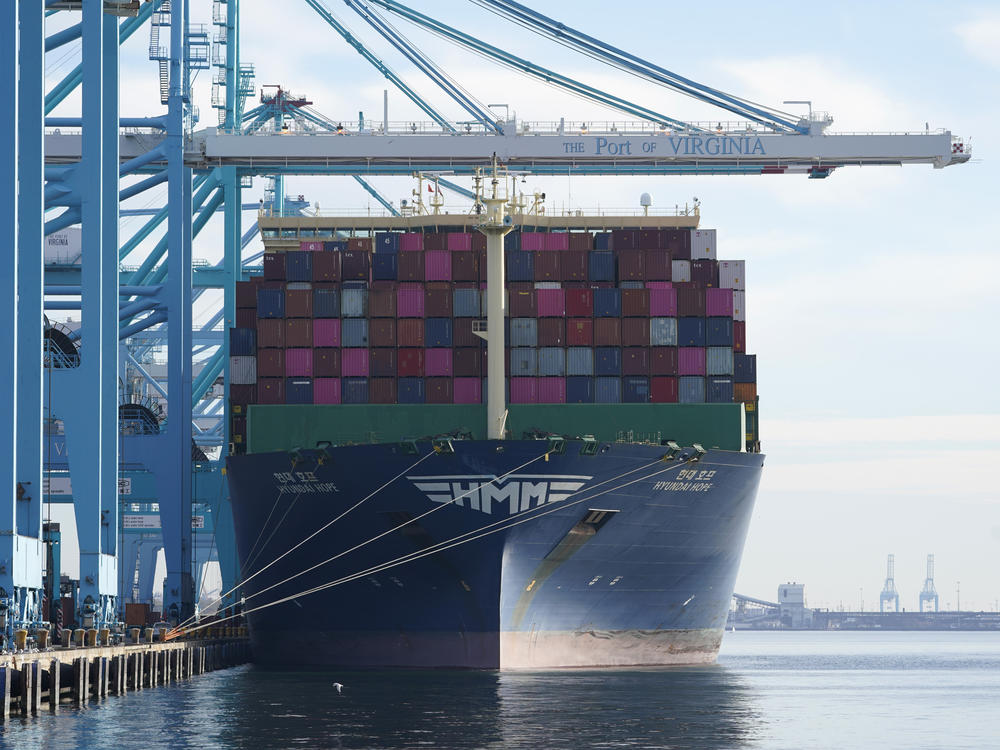Section Branding
Header Content
The global supply chain is amazingly efficient. So why did it break down?
Primary Content
Wall Street Journal columnist Christopher Mims says the global supply chain has become so cost effective that it can lead to surprising detours. That's the case with cod fish caught in Scotland, which are frozen and sent to China or Southeast Asia to be filleted, and then shipped back to Scotland to be sold.
"It's a journey of many thousands of miles, because transporting that cod is so much cheaper than paying domestic workers to prepare that cod," Mims says.
Mims' new book, Arriving Today, takes a close look at the global supply chain, following a hypothetical USB charger from a Vietnamese factory where it's made to its delivery to a home in Connecticut. That journey traverses 14,000 miles and 12 times zones, and involves a complex network of barges, shipping containers, trucks, warehouses, robots and workers.
Mims calls modern container ships "the most efficient way we've ever invented to move goods." And yet, the global supply chain is not without disruptions — especially during the pandemic. There have been price spikes and shortages of big-ticket items like cars and building materials, as well as products as common as toilet paper and cream cheese. Mims says those issues can frequently be traced back to labor shortages and increased demand.
"Basically, Americans went on a shopping spree as soon as lockdown started, and we haven't really stopped since," he says. "We are ordering so much stuff and we have transferred so much of our spending from services — like hospitality, going on vacations, eating out — to goods that it has really jammed up the works of the global supply chain. It's totally a demand issue."
Interview highlights
On the labor shortage contributing to supply chain disruption
Supply chains are really made out of people. As much automation as there is in there, if you don't have the people to run all of that automation and to work alongside it, you cannot move those goods quickly enough or in sufficient quantities, and their price goes up. So the labor crunch is the supply chain crisis, is the [increase] in inflation, is the sort of global macro macroeconomic problem of our time. It really all comes back to supply chains and to people.
On the scale of container ships
Picture the Empire State Building laid on its side. It's almost exactly those dimensions. The largest of them, the very largest, you can put four soccer pitches on their deck and still have a little bit of room left over. But you're talking about a vessel that from the water line to the top is 15 stories tall. And the biggest of them can carry 10,000 40-ft. shipping containers. ... It just drives the cost down by making these ships bigger and bigger.
On crew life on a container ship
To be a crew on a modern ship that's moving shipping containers has jokingly been compared to being in prison. But it's only sort of half joking. It's like you're living in an office building that you can never leave. You're going to see sunset and sunrise, and they might be stunning, but you're sort of confined to the bridge, especially if you're an officer, and your job is managerial and you're doing navigation. And if you're a so-called able-bodied seamen, you might be walking the ship doing repairs.
But the other joke about this is, become a sailor, travel around the world, see none of it. Because when these ships arrive in port, that whole process is so swift, so automated. These ships can be turned around in as little as 24 hours. These sailors might not even have a chance to leave the ship when they arrive in port, and yet they might be on a six-month round-trip journey halfway around the world. And so the life of a modern sailor is, I think, in some ways it's very lonely. They're not allowed to drink onboard. They're very rarely going ashore. It's strangely kind of an office job on the high seas.
At minimum, these ships need maybe a dozen people for a skeleton crew. But the size of the crews keep shrinking even as the ships keep growing.
On there not being enough long-haul truckers willing to do the job
We don't have so much a shortage of long-haul truck drivers in the United States as we have a burnout and retention problem. So there are three or four times as many people as are driving trucks [who] currently have the license, which should allow them to drive trucks, which just shows you how many people tried that job and said, "This isn't for me." So long haul trucking is an extremely fragmented industry. Even the biggest carriers, the ones whose names you might recognize from road trips, like Werner or Swift or whatever, even those biggest carriers, if you combine them all, there's still less than a fifth of all the capacity of long-haul truck transportation in the U.S. ...
When shipping rates drop, a lot of these small companies get wiped out. At the same time, because more and more demands are being placed on these drivers — especially throughout the pandemic, because so much more material was being shipped — it's become a lifestyle that a lot of people just find completely unsustainable.
On the grueling physical labor of Amazon warehouses and the pressure to keep pace
[Amazon has] so many of these fulfillment centers, more than 100 all over the United States, and by the way, that's just the giant million-square-foot fulfillment centers, that doesn't include the hundreds of other warehouses that they use for other purposes. The challenge is they're employing so many people — more than a million and a half people now — that I'm not sure that that standard allows them to retain enough workers. They have turnover above 100 percent at these warehouses, typically, which means that 100 percent of those workers on average are going to be gone after one year. So are there enough people for them to continue hiring? That's one reason that they have instituted $18 an hour for these Amazon workers in the warehouses. That attracts a lot of people. Sometimes it even attracts people to come back seasonally. But that's been Amazon's approach, rather than changing the pace of work.
On why this efficient system broke down during the pandemic
This amazingly efficient system broke down during the pandemic because it was asked to do more than it ever has. Supply chains are designed to flex on a seasonal basis. Shippers know, OK, holiday season is coming. It's September. We better requisition our shipping containers and buy all of our goods and get them starting to move to us so they can be in stores by October, November. But we needed so much material so quickly, whether that was PPE, or toilet paper or lumber, that that system was asked to move as much goods as it normally would during the peak of the holiday season, but really for months. Just starting within a couple of months after the pandemic kicked off and we were all locked down and we were all ordering things at home, every link in that supply chain, from ocean vessels to long-haul trucks to last-mile delivery, was asked to operate at its peak capacity.
On how these supply chain issues aren't going to be fixed anytime soon
I think that the supply chain problems we're having now, which are at the root of current inflation, are going to persist for a long time. And part of that is because we just have more demand for goods and that seems to be persistent. And part of that is because we're just ordering more stuff online and we're ordering more stuff in different ways through e-commerce. And the other part of it is that we live in a world now where it's not just about pandemics. This news gets missed because Delta and Omicron kind of swamp it, but there have been all kinds of disasters, natural disasters, extreme weather, political issues which have shut down ports and factories all over the world.
Malaysia got shut down, and this is a key link in the global semiconductor supply chain, because of COVID. That was months ago. Well, a lot of those facilities have been shut down again because of severe flooding in Malaysia. So what happens is these single points of failure can get hit by all kinds of different disasters. And then you wake up tomorrow and unexpectedly lumber prices are really high or you can't get a new car because one microchip was missing. So I think that these intermittent outages are going to persist for a very long time. It's kind of just the nature of global supply chains now.
Phyllis Myers Sam Briger and Kayla Lattimore produced and edited the audio of this interview. Bridget Bentz, Molly Seavy-Nesper and Meghan Sullivan adapted it for the Web.
Copyright 2022 Fresh Air. To see more, visit Fresh Air.


